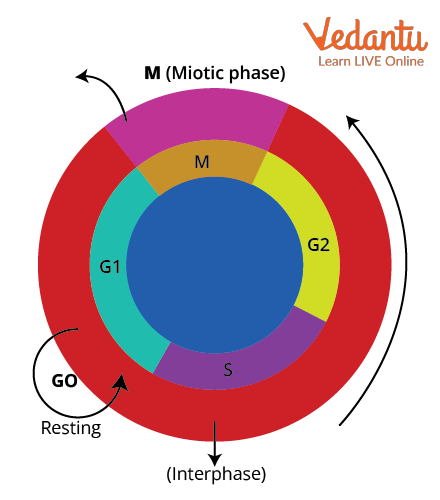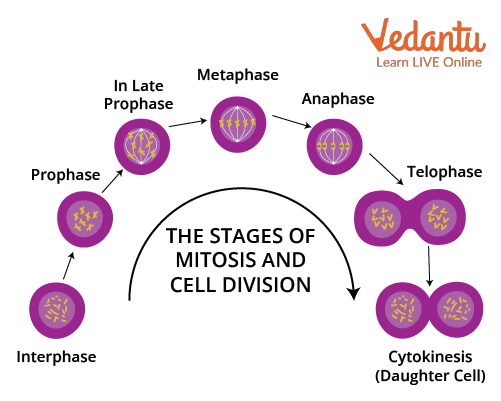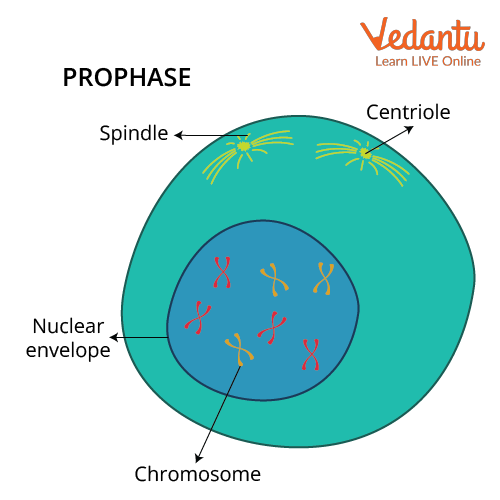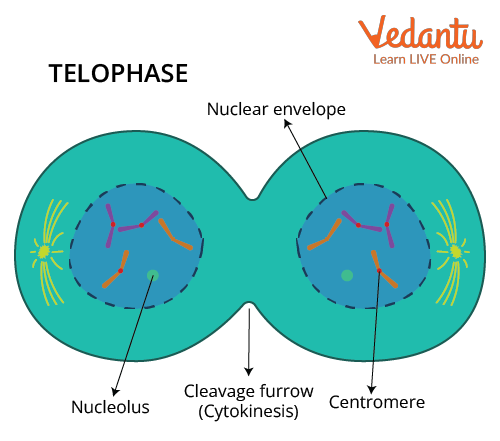




What is Cell Cycle?
The succession of occasions by which a cell copies its genome and synthesises any remaining cell contents and then ultimately separates into two daughter cells is known as cell cycle. The cell cycle is a four-stage process in which the cell increases in size (gap 1, or G1, stage), duplicates its DNA (synthesis, or S, stage), prepares for division (gap 2, or G2, stage), and divides (mitosis, or M, stage).
The cell cycle is partitioned into two stages called (I) Interphase: the period of preparation for cell division, and (ii) Mitosis (M stage): the real-time cell division. Interphase is additionally partitioned into G1, S, and G2. The G1 stage is the period when the cell develops and completes normal metabolism.
In unicellular organisms like Amoeba, Euglena, and Paramecium, growth and reproduction occur simultaneously. However, in multicellular organisms, growth and reproduction are distinct processes.
Phases of Cell Cycle
(A) Interphase
Interphase cell cycle is further divided into different phases.
(B) M Phase: Here, actual cell division happens. The number of chromosomes in the parent and daughter cells remains the same, so it is called equational division.
(C) Karyokinesis: The nuclear division is trailed by cytokinesis, for example, the division of the cytoplasm to bring about two daughter cells.
(D) Cytokinesis: Division of the cytoplasm, leading to the formation of two daughter cells.

Phases of Cell Cycle
Cell Division
Cell division happens when cells multiply involving both nuclear and cytoplasmic divisions.
There are two sorts of cell division: mitosis and meiosis.
More often than not when individuals refer to "cell division," they mean mitosis, the most common way of making new body cells.
Meiosis is the kind of cell division that makes egg and sperm cells. Mitosis is a fundamental process.
Mitosis

Different Stages of Mitosis
Prophase

Prophase of Mitosis
It is the first and the longest phase of mitotic cell division.
Chromosomes become visible as short and thick.
Each chromosome splits into two chromatids connected at the centromere.
The nuclear membrane and nucleolus start dissolving.
Chromosomes become shorter and thicker.
Metaphase
Nuclear membrane and nucleolus disintegrate and disappear completely.
Spindle fibres start appearing and these fibres get attached to chromosomes at centromeres.
Chromosomes become shorter and thicker.
Chromosomes arrange themselves in the centre or on the equatorial plate.
At the end of metaphase, the two chromatids of each chromosome also start separating.
Anaphase
Chromatids separate from each other at the centromere and are called daughter chromosomes.
These daughter chromosomes move to the opposite poles forming “U” or “J” shapes during their movement towards the pole.

Telophase of Mitosis
Daughter chromosomes are now at the end of the spindle, i.e., present at the opposite poles.
Reformation of the nuclear membrane around each daughter chromosome.
Nucleolus reforms.
Two nuclei are thus organised singly at each pole of the parent cell.
Chromosomes begin to lose their compact structure.
Spindle fibres disappear gradually.
Cytokinesis
In animal cells, a ring of actin filaments forms at the metaphase plate.
The ring contracts, forming a cleavage furrow, which further divides the cell in two.
In plant cells, Golgi vesicles coalesce at the metaphase plate, forming a phragmoplast.
A cell plate formed by the fusion of the vesicles of the phragmoplast grows from a centre toward the cell walls and the membranes of the vesicles fuse to form a plasma membrane which divides the cell in two.
Significance of Mitosis
It results in the formation of two daughter cells identical to the parents.
DNA is distributed equally due to this process in both the daughter nuclei.
Both daughter cells are identical and have the same genetic constitution.
The number of chromosomes remains the same from one generation to the other.
It is used for growth and repair.
Cells are diploid.
It is the only way to increase the cell number without changing the genetic material.
Mitosis always maintains the gap between two rounds of cell division which is essential for
Repair of DNA damages
And cytoplasmic growth of the cell.
Meiosis
Meiosis is a kind of cell division that reduces the number of chromosomes in the parent cell significantly and produces four gamete cells.
This interaction is expected to deliver egg and sperm cells for sexual reproduction.
The consequence of meiosis is the development of four unique cells, each conveying another combination of genes and chromosomes, and each with a half of the quantity of original chromosomes, subsequently maintaining the chromosome number of an animal variety from one generation to another.
The significant periods of meiosis include Interphase, prophase I, metaphase I, anaphase I, telophase I, cytokinesis, interphase II, metaphase II, anaphase II, and telophase II.
Phases of Meiosis
Interphase
Prophase I
Metaphase I
Anaphase I
Telophase I
Cytokinesis
Interphase II
Metaphase II
Anaphase II
Telophase II
Key Features of Meiosis-
Ensures Genetic Variation
Meiosis introduces genetic diversity through crossing over (exchange of genetic material between homologous chromosomes) and independent assortment (random distribution of chromosomes).
This variation is essential for evolution and adaptation.
Maintains Chromosome Number Across Generations
Meiosis reduces the chromosome number by half, producing haploid gametes (sperm and egg cells).
When fertilization occurs, the diploid number is restored, ensuring stability in species across generations.
Conclusion
This article has given all the necessary detail about the Phases of the cell cycle with respect to the NEET syllabus. The questions added at the end of the article are frequently asked questions and are important from the exam point of view and thus the student can have a clear understanding of the type of questions that might come in the exam.
Essential Study Materials for NEET UG Success
FAQs on Phases of Cell Cycle - Important Topic for NEET
1. How many questions can you expect from the cell cycle in the NEET examination?
This topic holds a strong weightage in the examination and on average 6 questions are asked from this unit. Almost every year, you can expect one question from this topic. It has around 10% weightage in the examination.
A student must thoroughly go through each line and diagram of the NCERT and make tables to revise these topics in the long run separately. Students can also get innovative with diagrams and can form sticky notes, mind maps, and mnemonics for better understanding and easy recalling during the examination.
2. What are the most important topics to cover from this part of the unit?
Though this complete topic is very important from an exam point of view, you surely can’t afford to miss the differences and characteristics between phases like prophase, metaphase, anaphase, and telophase.
The student should thoroughly read and practise NCERT with some additional information to sail through this examination. You must pay attention to every detail and diagram given in the book, you must practise and revise the concepts at a regular interval of time so that they will become easier to recall in the examination.
3. What are the main phases of the cell cycle?
The cell cycle consists of Interphase (G1, S, G2 phases) and M Phase (Mitosis and Cytokinesis), which regulate cell growth and division.
4. What happens during the Interphase of the cell cycle?
Interphase is the preparation phase where the cell grows, duplicates its DNA, and gets ready for division. It includes G1 (growth), S (DNA replication), and G2 (preparation for mitosis).
5. What is the significance of the M phase in the cell cycle?
The M phase (mitotic phase) is when actual cell division occurs. It consists of Karyokinesis (nuclear division) and Cytokinesis (cytoplasmic division).
6. How is mitosis different from meiosis?
Mitosis produces two genetically identical diploid cells, whereas meiosis results in four genetically unique haploid cells, essential for sexual reproduction.
7. Why is the cell cycle important for living organisms?
The cell cycle ensures growth, repair, and reproduction in organisms, maintaining genetic stability and allowing tissues to regenerate.
8. What role does the S phase play in the cell cycle?
The S phase (Synthesis phase) is crucial for DNA replication, ensuring that each daughter cell receives an identical copy of genetic material.
9. How can I prepare for NEET questions on the cell cycle?
Focus on NCERT diagrams, key differences between phases, and processes like mitosis, meiosis, and cytokinesis. Practicing previous year questions is also helpful.
10. How much weightage does the cell cycle hold in the NEET exam?
The cell cycle and cell division typically carry around 10% weightage in the NEET Biology syllabus, with at least one question asked in most exams.










